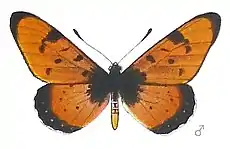| Acraea pseudolycia | |
|---|---|
 | |
| A. pseudolycia forms and subspecies | |
| Scientific classification | |
| Domain: | Eukaryota |
| Kingdom: | Animalia |
| Phylum: | Arthropoda |
| Class: | Insecta |
| Order: | Lepidoptera |
| Family: | Nymphalidae |
| Genus: | Acraea |
| Species: | A. pseudolycia |
| Binomial name | |
| Acraea pseudolycia | |
| Synonyms | |
| |
Acraea pseudolycia is a butterfly in the family Nymphalidae, which is native to East Africa and Africa's southern subtropics.
Range
It is found in Angola, the Democratic Republic of the Congo, Zambia, Kenya, Tanzania, Malawi, Uganda, Sudan and Ethiopia.[3]
Description

A. pseudolycia can scarcely be distinguished by any constant external characters from zetes, but according to Eltringham has the lateral clasps of the male somewhat differently formed. All the forms most nearly approximate to the race acara and give the impression of an extreme development of this. The light groundcolour is more extended on the upper surface of both wings and the marginal spots of the forewing above are either entirely absent (being united with the ground-colour) or are small and placed in a greyish nebulous band which is not sharply defined; on the under surface they are never bounded proximally by a black lunulate line and are usually entirely absent; discal dots of both wings on an average smaller than in acara.[4]
- pseudolycia Btlr. (60 f). Ground-colour of both wings whitish; forewing above at the distal margin with a black-grey, proximally ill-defined nebulous band 5 to 6 mm. in breadth, which encloses small yellowish marginal spots, beneath with a sharply defined black apical spot 3 mm. in breadth, which from vein 4 onwards passes into a very fine marginal line. Angola.
- astrigera Btlr. (60 f). Ground-colour above bright yellow-red with rosy reflection; both wings above deep black at the base; forewing with black apical spot about 4 mm. in breadth, which passes posteriorly into a fine marginal line; no marginal spots. The female with duller, more yellowish ground-colour. Rhodesia to British East Africa.
- female ab. emini Weym. is larger and has the forewing above not or little darkened at the base. German East Africa.
- f. brunnea Eltr. (60 f) only differs in the yellow-brown ground-colour of the upper surface; sexes similar. Angola; Rhodesia; German East Africa.[4]
Subspecies
- Acraea pseudolycia pseudolycia — Angola, western Zambia, Democratic Republic of the Congo: Lualaba, Maniema
- Acraea pseudolycia astrigera Butler, 1899 — central and eastern Kenya, Tanzania, eastern Zambia, Malawi, northern Uganda, Sudan, Ethiopia
Taxonomy
Acraea pseudolycia is a member of the Acraea anemosa species group. The clade members are:
- Acraea anemosa
- Acraea pseudolycia
- Acraea turna
Classification of Acraea by Henning, Henning & Williams, Pierre. J. & Bernaud
References
- ↑ Butler, A. G. 1874 Descriptions of new African Lepidoptera Cistula ent. 1 (8) : 209-214,[215-217] (misnumbered pages)
- ↑ "Acraea Fabricius, 1807" at Markku Savela's Lepidoptera and Some Other Life Forms
- ↑ "Afrotropical Butterflies: Nymphalidae - Tribe Acraeini". Archived from the original on 2012-08-10. Retrieved 2012-05-31.
- 1 2 Aurivillius, [P.O.]C. 1908-1924. In: Seitz, A. Die Großschmetterlinge der Erde Band 13: Abt. 2, Die exotischen Großschmetterlinge, Die afrikanischen Tagfalter, 1925, 613 Seiten, 80 Tafeln (The Macrolepidoptera of the World 13). Alfred Kernen Verlag, Stuttgart.
 This article incorporates text from this source, which is in the public domain.
This article incorporates text from this source, which is in the public domain. - ↑ Henning, G. A., 1993 Phylogenetic notes on the African species of the subfamily Acraeinae. Part 2-3. (Lepidoptera: Nymphalidae) Metamorphosis 4 (1): 5-18, (2): 53-68
- ↑ Henning, G. A. & Williams, M. C. 2010 Taxonomic notes on the afrotropical taxa of the tribe Acraeini Boisduval, 1833 (Lepidoptera: Nymphalidae: Heliconiinae) Metamorphosis 21 (1): 2-38
- ↑ Pierre, J. & Bernaud, D., 2013 Nymphalidae XXIII. Acraea subgenus Acraea Butterflies of the World 39: 1-8, pl. 1-28 Goecke & Evers
- ↑ Pierre & Bernau, 2014 Classification et Lsste Synonymique des Taxons du Genre Acraea pdf